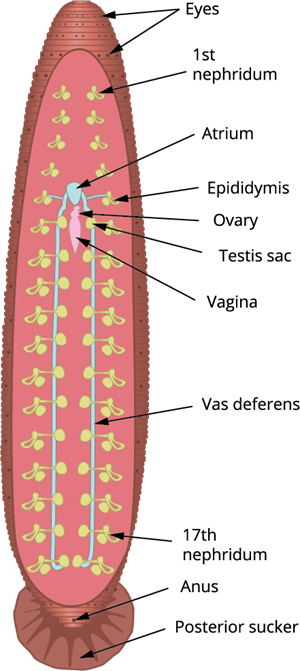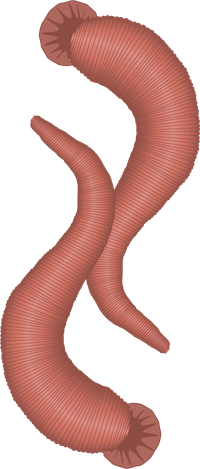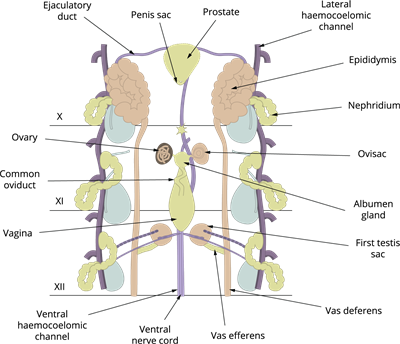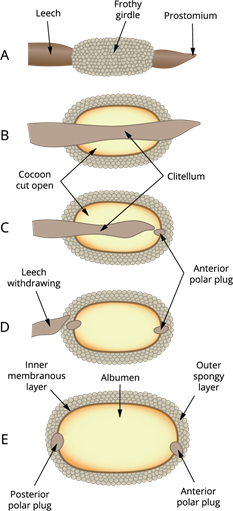
PUMPA - SMART LEARNING
எங்கள் ஆசிரியர்களுடன் 1-ஆன்-1 ஆலோசனை நேரத்தைப் பெறுங்கள். டாப்பர் ஆவதற்கு நாங்கள் பயிற்சி அளிப்போம்
Book Free DemoReproductive system helps in the continual of the species. Leeches are having both male and female reproductive organs in their body. But, leeches don't self- reproduce. In this topic we are going to see about the reproductive system of leech.

Reproductive system of leech
General terminologies:
| Hermaphrodites | An organism that possesses both male and female sexual organs or traits. |
| Clitellum | In earthworms and leeches, a thickened saddle-like area of epidermis whose secretions bind copulating worms together and later form a cocoon around the eggs. |
| Spermatophore | The male of various lower animals (such as annelids and arthropods) creates a protein capsule carrying a mass of spermatozoa, which will be delivered to the female's reproductive system. |
| Testes | It is a male reproductive organ. |
| Spermatozoa | Male reproductive cells. |
| Vas efferens | Any of several tiny ducts that carry sperm from the testis to the epididymis. |
| Epididymis | It is a coiled segment of the spermatic ducts that stores and transmits spermatozoa to the vas deferensafter they have matured. |
| Prostate gland | It is a tiny organ present in the body of an organism near the bladder that secretes sperm-carrying fluids. |
| Genital atrium | A tiny cavity in the body wall into which the female and male genital ducts open. |
| Penis | A male genital organ. |
| Ovaries | A pair of ovaries which produces ovum. |
| Oviduct | A tube which helps to transport ovum to the vaginal pore. |
| Vagina | A female genital organ. |
The video explaining the reproduction of leech.

Two leeches in copulation
Leeches of reproductive maturity begin generating sperm and eggs during mating season, which lasts from early June through August. During this time of year, the clitellum (a band of tissues that secretes the cocoon) may grow and become visible.
Leeches are hermaphrodites, meaning they have both male and female reproductive parts in the same animal. However, auto-fertilization does not occur. Because the female and male reproductive organs aren't active simultaneously in the life cycle, the leeches must locate mates.

Reproductive organs of 10, 11 and 12 'th segments f the leech body
Male reproductive system:
There are eleven pairs of testes in total, one pair in each of the segments \(12\) to \(22\). They come in the form of testes sacs, which are spherical sacs. A short duct called the vas efferens emerges from each testis and connects to the vas deferens. To store spermatozoa, the vas deferens becomes twisted and forms the epididymis, or sperm vesicle.
The epididymis leads to the ejaculatory duct, which is a short duct. The genital atrium is formed when the ejaculatory ducts on both sides connect.
The coiled prostate glands and the penial sac, which contains the penis and opens through the male genital pore, make up the atrium.
The coiled prostate glands and the penial sac, which contains the penis and opens through the male genital pore, make up the atrium.
Female reproductive system:
Ovaries, oviducts, and vagina make up the female reproductive system of the leech. There is a single pair of ovaries present on the ventral side of the 11th segment. Each ovary is formed like a coiled ribbon-shaped structure.
The ova are developed from the ovary. A short oviduct runs from each ovary. The oviducts from both sides connect to form a common oviduct.
The common oviduct opens into a pear-shaped vagina in the posterior half of the\(11\)th segment, located mid-ventrally.
The common oviduct opens into a pear-shaped vagina in the posterior half of the\(11\)th segment, located mid-ventrally.
Development of cocoon:

Stages in cocoon formation
A and B. Formation of frothy girdle
C. Formation of anterior plug
D. Formation of posterior plug
E. Cocoon seen in section
Before we learn about the development of cocoons, important terminologies must be known for a better understanding.
The fusion of male and female gametes is known as fertilisation.
It is two types.
1. Internal fertilisation: The development of an embryo occurs inside the female's body.
2. External fertilisation: The development of an embryo occurs outside the female's body.
2. External fertilisation: The development of an embryo occurs outside the female's body.
Types of development:
The development of an embryo is of two types.
1. Direct development: The young organism develops and resembles the adult organism.
2. Indirect development: Young organisms undergo different stages during their development, and it is also known as metamorphosis.
2. Indirect development: Young organisms undergo different stages during their development, and it is also known as metamorphosis.
Stages of development in leech:
- Post internal fertilization, the formation of a cocoon is developed. The cocoon, also known as the egg casing, forms around the \(9\)th, \(10\)th and \(11\)th segments.
- Direct development occurs in cocoons containing \(1\) to \(24\)embryos.
- A young leech that looks like an adult.